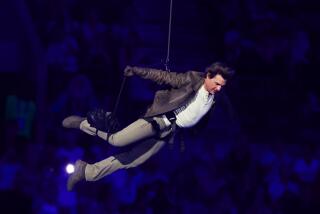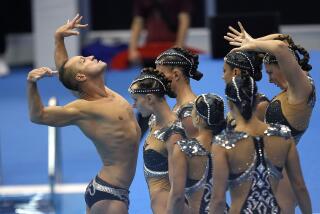Here’s a Vote for Todd to Join the Mod Quad Squad
NAGANO, Japan — For some, the quad is the four-letter word in men’s figure skating.
Me? I think it should be a required element at the Olympics, like a Visa card. The quadruple jump separates the medalists from the boys.
I don’t really mean to challenge a skater’s manhood if the best he brings to Saturday night’s freestyle program at the White Ring is a triple axel, especially if it’s done in combination with another triple jump.
The triple axel requires 3 1/2 revolutions and should always be respected. But if a skater wants to win the gold medal, he’d better be prepared to go the extra one-half revolution.
As a result, my yen is either on Russia’s Ilia Kulik or Canada’s Elvis Stojko. If anyone else wins, you’ll know you haven’t seen figure skating at its finest. That, unfortunately, occurs more often than not at the Winter Olympics.
In an article for Newsweek, Brian Boitano, one of the exceptions who did win a gold medal by performing at an extraordinarily high level, wrote, “Olympic figure skating is often decided . . . by who is left standing.” Could that be Todd Eldredge this time?
It’s possible. He is a five-time U.S. champion, the 1996 world champion, and has done well enough in the sport to afford a Ferrari. No one could argue with the third-place marks he received for Thursday night’s short program behind Kulik and Stojko.
If they fall in the long program and he skates cleanly, Eldredge probably will become the United States’ first male figure skating gold medalist since Boitano in 1988.
Knowing Eldredge, I doubt he would like to hear his chances characterized like that. But it’s true because he has never landed a quad and doesn’t appear as if he’s going to start this week.
Eldredge, a commercial fisherman’s son from South Chatham, Mass., likes to claim he doesn’t need one to be considered the world’s best figure skater.
“We really can’t stray too far into saying it comes down to one jump,” he says.
But in last month’s national championships in Philadelphia, Eldredge unexpectedly slipped one into his long program. Although he fell, it was an admission that he would like to have the quad in his repertoire.
His coach, Richard Callaghan, didn’t want Eldredge to try the quad in Philadelphia. Callaghan doesn’t want Eldredge to try it here.
Asked if he will try it, Eldredge says coyly, “We’ll see.”
If his practices this week are an indication, though, he has about as much chance as Akebono of becoming the first American to perform one cleanly in a competition.
Boitano aimed for that distinction 11 years ago.
It was such a novel concept that his coach, Linda Leaver, feared the judges wouldn’t recognize it. She considered holding up a sign informing them they had just witnessed a quad if he did one.
She never got the chance.
Boitano did fine without one. But the sport has changed since then.
Some traditionalists don’t particularly like the direction it has taken. That includes Boitano, who wrote in the Newsweek article that he doesn’t want figure skating to become a sport like track and field that rewards only speed and jumping.
It’s a fine line. Judges don’t want to see skaters trying such difficult maneuvers that they’re routinely falling. At the same time, figure skating, like any sport, has to constantly evolve.
The quad era began 1990, when Canadian Kurt Browning landed the first quadruple toe loop. Stojko has taken it to another level, performing it in combination with a triple toe loop.
Predicting a Stojko gold medal, France’s Philippe Candeloro says, “There’s only one man in the world who can do a quad followed by a triple jump, and that’s Elvis.”
Stojko, a three-time world champion and silver medalist in the 1994 Winter Olympics, is a martial arts expert who idolizes Bruce Lee. A well-traveled rumor last summer had him using his kung fu skills to overpower hockey star Eric Lindros in a bar fight. It wasn’t true, but it was significant that everyone who knows him believed it could have been.
His short program Thursday night, performed to Kodo drums, was powerful and primal.
In an interview earlier this week, he got onto a topic that he repeated, in somewhat similar form, after the short program.
“Everyone is always talking about getting in touch with their feminine side, about being sensitive and soft,” he said a few days ago. “But I prefer to get in touch with my masculine side.
“Skating can be done in a masculine way. I’m a man. I skate masculine. You can be sensitive but powerful. That’s how I look at this. If everybody skated the same way, it would be boring.”
The judges in the short program preferred Kulik, a baby-faced Russian who skated to the synthesized sound of French composer Jean-Michael Jarre. It certainly was a more traditional program, complete with a winged costume that must have been picked out by his mother, but don’t be lulled to sleep in the long program. You might miss him try a triple toe loop in combination with his quad.
He and Stojko are going to step inside and settle this like men--mano a mano, quad to quad.
Let’s get ready to rumble.
More to Read
Go beyond the scoreboard
Get the latest on L.A.'s teams in the daily Sports Report newsletter.
You may occasionally receive promotional content from the Los Angeles Times.






